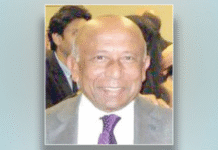
As Bangladesh struggles to allocate its stretched resources to fight the spread of Covid-19, which has already claimed 20 lives as per official estimates, children in the remote areas of the Chittagong Hill Tracts (CHT) are falling victim to another disease—a highly contagious but preventable one—measles.
According to newspaper reports, 10 children have already died in the CHT since the outbreak began on February 26, when the first death was reported. Another 300 children have been infected. The disease has spread to five remote villages under Sajek Union in Rangamati: Arun Tripura Para, Lungthian Tripua Para, Tarun Tripura Para, Kamalapur Chakma Para, and Kaikhya Tripura Para. The obvious question is: why?
With the government target of eliminating measles and rubella by 2023 and the stepping up of efforts to achieve this goal, the death of innocent children to this disease is disturbing. The government and development agencies spend millions every year on the Expanded Programme on Immunization (EPI) to protect children from preventable diseases though vaccination.
This year as well the government, with the help of partner organisations, is importing vaccines worth USD 42 million from the Serum Institute of India, informed Md Shamsul Haque, Line director of the Directorate General of Health Services. And according to Dr Stephen Chacko, who has worked with the World Health Organization (WHO) as medical officer for immunisation and vaccine development, Bangladesh has demonstrated “good coverage” of measles immunisation, bringing around 85 percent of children under measles vaccine coverage, as reported in a local newspaper.
But the number of measles-infected children in Bangladesh has shown a marked increase since 2016 when the figure stood at 165, according to the US based Centers for Disease Control and Prevention (CDC). According to Bangladesh‘s official estimates circulated in local newspapers, the figures stood at 71 in 2017, 36 in 2018 and 82 in 2019, whereas the official figure stood at 4 in 2015, in the wake of a large-scale measles vaccination programme in 2014. According to CDC data for 2015, the number of confirmed cases stood at 250.
Aside from the obvious discrepancy between official and CDC data, what remains a concern is the number of growing cases of measles in Bangladesh; the Rohingya camps in Cox‘s Bazar being one of the hotbeds for this disease. Amidst the overcrowded camps and the compromised sanitation conditions, contagious diseases lurk waiting to claim their victims. And measles has remained a major concern, along with diphtheria, ever since the persecuted Rohingya refugees started crossing the Naf river to Bangladesh in search of protection from the unspeakable horrors unleashed upon them by the Myanmar military.
The Bangladesh government, along with WHO, Médecins Sans Frontières (MSF), Relief Web and UNICEF, are working to address this problem, as are many other organisations. Immunisation programmes have been undertaken in the Cox‘s Bazar region, but children keep falling victim to this menacing pestilence.
According to MSF, 120 measles-infected patients were admitted in their isolation wards in January, while 900 other cases had been treated as outdoor patients. “In the first four weeks of the year, MSF saw a 40 percent jump in measles cases treated in our facilities in the refugee camps.”
And in the words of an MSF nurse—Mohammad Younus Ali—in Kutupalong Hospital, “Since November the cases have been increasing and increasing”.
According to Relief Web, in the Rohingya camps during the “first week of 2020, there were 264 measles cases reported with 0.7 percent morbidity. The number of measles cases has remained high since September 2019.” Although the number of cases have shown a declining trend in February and March, thanks to immunisation efforts—with 36 suspected measles cases being reported in week 11 of 2020 (Relief Web), measles remains far from eliminated across the country.
Failure to vaccinate children, despite multiple immunisation initiatives, remains one of the major reasons why measles remains an elusive affair in the CHT. Leaders of the communities in CHT affected by the measles outbreak this year have alleged that children in their villages had not been vaccinated: “The affected areas are out of vaccination coverage”, said Hiranando Tripura, a ward member of the area.
Bipash Khisa, civil surgeon of Rangamati, admitted that reaching the far corners of the region remains a daunting challenge for the vaccine providers—a challenge they often fail. According to Khisa, it can take up to 10 hours to reach the affected areas on foot from the Sajek tourist spot, as there is no other means of visiting those places. But does this justify the death of innocent children?
In the aftermath of the outbreak, the local authorities had said that they would take initiatives to address the situation. “We are going to take some inclusive work plans, including setting up five community clinics, sanitation, nutrition, and water management programmes in the affected areas,” said Ahosan Habib, upazila nirbahi officer (UNO) of the affected Baghaichhari Upazila.
But how much of it is actually going to be implemented remains a question. Even the government immunisation campaign that was supposed to vaccinate 34 million children between 9 months and 10 years for measles and rubella across the country had to be postponed in view of the continued spread of Covid-19.
And with the immunisation programme postponed, people—especially the ones living in the high-risk or affected areas—are apprehensive. The locals have urged the government to take effective measures to address the situation in CHT. In this regard, a joint statement by Kapaeeng Foundation and the Bangladesh Indigenous Peoples Forum has also been released.
“We think that such an outbreak would not have occurred if the government had reached peoples’ homes with immunisation programmes and healthcare,” read the statement. It also recommended four steps to tackle the situation, which include adequate medical care facilities in the affected regions.
But with limited resources already stretched in the fight against the menacing pandemic, how much the government would be able to do to address the woes of the people of the CHT, remain to be seen.
Despite the magnitude of the challenges ahead of the government, it must act now to protect the children of the CHT and other high-risk areas. Medical care is a basic right of every human being, and it is the duty of the government to make sure that not a single life is lost to preventable disease. While the healthcare providers and responsible officials who had failed to vaccinate the children in the affected areas should not be allowed to go scot-free with blood on their hands, the government needs to immediately allocate necessary resources to all high-risk and affected areas to save innocent lives.
Every child, every life is important, irrespective of who they are, where they live, and the time they live in.
Tasneem Tayeb is a columnist for The Daily Star. Her Twitter handle is: @TayebTasneem









